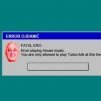-
Content Count
3087 -
Joined
-
Last visited
-
Days Won
139
Remy Lebeau last won the day on August 19
Remy Lebeau had the most liked content!
Community Reputation
1674 ExcellentTechnical Information
-
Delphi-Version
Delphi 12 Athens
Recent Profile Visitors
The recent visitors block is disabled and is not being shown to other users.
-
https://en.delphipraxis.net/topic/7289-line-break-after-i-type-if/
-

Destroying a TThread recreating TThread the destroying again hangs Process
Remy Lebeau replied to JackT's topic in Delphi IDE and APIs
Yes, there is - use the TThread.OnTerminate event to signal your waiting code, such as via a TEvent object. Just know that the event handler is called in the main thread, so if that will cause a sync issue, you can always override the TThread.DoTerminate() method to call the OnTerminate handler directly (or do anything else) without syncing it, as DoTerminate() is called in the worker thread and calls the OnTerminate handle via TThread.Synchronize() by default. -
So you are saying it was working the other day in 13 and now its not? Or, were you using an older version before and then upgraded to 13 and it stopped working?
-

Can't set Property Editor for Set or Enum
Remy Lebeau replied to Cobalt747's topic in Delphi IDE and APIs
What are you trying to accomplish, exactly? Do the default property editors work correctly without registering your custom editors? Why are you registering the editor for Boolean instead of TTestValue? -
Worse case, you can try manually setting the modal dialog's PopupParent to the active form (the VCL should already be doing that, but maybe its buggy?).
-
The 1st patch was supposed to fix a problem with missing Indy components. It didn't work. There is a 2nd patch to fix that. https://www.indyproject.org/2025/09/28/indy-patches-for-rad-studio-13-florence/
-
Hmm, I don't think they should have re-declared IAccessible. They should have had Winapi.UIAutomation use Winapi.oleacc instead. Even the SDK uiautomationcore.h header doesn't redeclare IAccessible. The new IAccessibleEx inherits from the IAccessible in oleacc.h. Agreed. I would say it needs more work.
-
cgrc.exe is for the IDE's internal use when invoking rc.exe with brcc32-style parameters. If a script wants to invoke rc.exe then it should probably just invoke it directly.
-

Recover from call to dll that doesn't return
Remy Lebeau replied to Renate Schaaf's topic in Windows API
Have you considered moving your audio processing into a separate process of its own that your main program can communicate with. If the processing times out then your main program can kill and restart that separate process. That way, you don't have to kill your main program. -
It is possible with some additional tweaking. You can go into the compiler's linker options and set the PE header OS Version and SubSystem Version fields to 5.0 for Win2K or 5.1 for XP. Also, if you use the System.Threading unit then make a copy of it, modify it to call GetTickCount() instead of GetTickCount64() on pre-Vista systems, and then add the copy to your project.
-
It's not a bug. Starting with 13, the Windows SDK is no longer bundled with the IDE, it needs to be installed separately, and rc.exe is part of the SDK: https://docwiki.embarcadero.com/RADStudio/Florence/en/What's_New#Installation_Process_Updates A new open-source resource compiler named resinator has been added in 13 and is now the default: https://docwiki.embarcadero.com/RADStudio/Florence/en/What's_New#Resource_Compiler So, if you want to continue using rc.exe, you need to install the Windows SDK (or copy it from an earlier installation, as you found). At the project level, you can configure which resource compiler to use (brcc32, resinator, or rc): https://docwiki.embarcadero.com/RADStudio/Florence/en/Resource_Compiler_Options
-

New Delphi features in Delphi 13
Remy Lebeau replied to David Heffernan's topic in RTL and Delphi Object Pascal
I'm human and even I don't understand the question you asked it. You can't write code that targets just RAD Studio itself, because it is not a separate compiler of its own. It uses either the Delphi compiler or the C++Builder compiler. RAD Studio simply bundles them together under one IDE. That's also why you can't have Delphi(Standalone) + RADStudio or C++Builder(Standalone) + RADStudio installed together. The standalone versions are just slimmed down versions of RAD Studio. One IDE, multiple personalities. -
It was added in Delphi 11 Alexandria: https://docwiki.embarcadero.com/RADStudio/Alexandria/en/What's_New#RTL:_TZipFile
-
https://docwiki.embarcadero.com/RADStudio/Florence/en/What's_New#Installation_Process_Updates comdef.h is one of many SDK headers affected by this change. As _bstr_t and _com_error are Win32 classes, you will need to install the Windows SDK to continue using them.
-
Seconded.
![Delphi-PRAXiS [en]](https://en.delphipraxis.net/uploads/monthly_2018_12/logo.png.be76d93fcd709295cb24de51900e5888.png)









